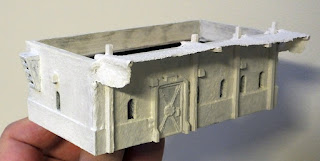With the first proof-of-concept height boosted house a success, I cut a whole load of 5mm wide strips of 5mm thick foamcore. These are cut to the length of the sides of the buildings, less 5mm to allow an overlap on one end. As with the test house, they are glued on with PVA. These are trimmed if required after the glue has dried for several hours.
 |
Foamcore and card ready for use.
|
A 10mm wide strip of cereal packet card is added around the bottom of
most buildings to hide the different materials and strengthen the join. I find that the boxes of Tesco Malt Wheats are
especially good for this, being a particularly good quality, thick
card. I was always intending to add something around the bottom of all the
buildings to reduce the characteristically slab-sided MDF look, and now it has the added bonus of concealing the foamcore and
fixing it firmly with the overlap. This is stuck on with a good layer
of quality PVA glue (not the cheaper watered down "school glue" type). A smear of wood filler is applied on the corners of the buildings to conceal the tell-tale interlocking MDF tabs, and over the engraved shutters present on some houses. I also try to fill the gap around the protruding ends of the roof beams.
 |
Engraved shutters filled in and corner joints concealed.
|
 |
Cardboard "skirt" hides the foamcore and reinforces the joint.
|
 |
Metal vent conceals the old engraved doorway.
|
Additional details are added to enhance the sci-fi look of the buildings. I have a variety of bits for this. Some of the scrap MDF makes a good sun canopy and more scrap pieces provide uprights for some mysterious purpose. Matchsticks are fitted between the 3 on the far side.
 |
Lots of MDF scrap used on this one.
|
Broken pieces of kid's toys are handy, I've used part of a support from a Hexbug set, a 2x2 Lego tile with a couple of zip-tie pieces for vents, bits of 3D printing supports for cables. Other small MDF off-cuts will become electrical junction boxes.
 |
Bits of toys, zip ties, all make good greebles.
|
More MDF offcuts give a nice parapet to the roof, a piece of coffee stirrer forms a small canopy over the door. This one is getting embossed
plasticard stonework instead. This is glued on with superglue, making
sure it only goes on the top half of the strip so that it doesn't melt
the exposed foam inside the foamcore.
 |
MDF scrap around the roof, embossed plasticard skirt.
|
The ladder is made from bird feeder mesh. Small pieces of 3D printer support have been added to the walls.
 |
Bird feeder mesh ladder.
|
On this smaller building, I've used a couple of pieces of clothes hanger, a Lego wheel for the chimney and another bit of coffee stirrer over the door. I attach them using superglue, then use more superglue sprinkled with some bicarbonate of soda to give a really tough bond.
 |
One of the smaller buildings.
|
Small scraps of card will break up the flat surfaces.
 |
Lego wheel chimney.
|
Clothes hangers really are a great source of bits, especially the ones for trousers. Lots of long, straight sections of an even width, excellent as heavy duty steel beams or columns.
 |
Clothes hanger metal columns.
|
Once they have enough detail, the buildings will be covered with a layer of texture paste to give a more varied appearance. More on that another day...










































































